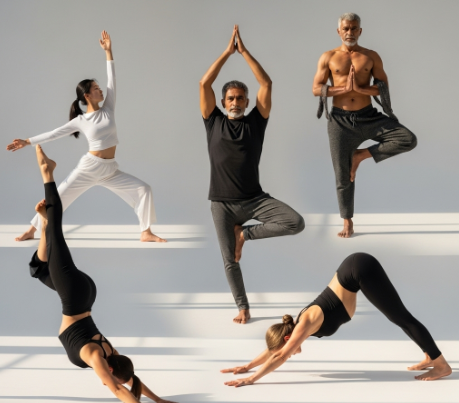Yoga for Core Strength: 3 Beginner Poses for a Stronger Back & Better Posture
Top 3 Beginner-Friendly Yoga Poses for 360° Stability (Expert-Recommended)
Forget endless crunches! While traditional abdominal exercises have their place, certified yoga instructor Annelise Piers reveals how specific beginner-friendly yoga poses can deliver unparalleled "360° core stability" by engaging deep, often-overlooked stabilizing muscles. This holistic approach not only sculpts your core but also improves posture, alleviates back pain, and enhances overall athletic performance.
 |
| Yoga for Core Strength: 3 Beginner Poses for a Stronger Back & Better Posture |
Many of us equate core strength with visible six-pack abs, leading to endless repetitions of crunches and sit-ups. However, as certified yoga instructor Annelise Piers, whose expertise is highlighted in this Fit&Well article, emphasizes, true core strength goes far beyond the superficial. Yoga, unlike conventional abdominal workouts, excels at activating the deep, intrinsic muscles that support your spine and pelvis. This creates a comprehensive "360° core stability" that underpins every movement, significantly improving posture, reducing nagging back pain, and boosting overall athletic performance.
Here, we delve into three fundamental, yet incredibly effective, yoga poses that beginners can master to build a powerfully stable core.
1. Plank Pose (Phalakasana): The Foundation of Core Strength
The plank is a cornerstone of core training, renowned for its ability to engage multiple muscle groups simultaneously, creating a solid, stable foundation.
 | |
|
How to Perform
Starting Position: Begin on your hands and knees, ensuring your wrists are directly beneath your shoulders and your knees are under your hips. Spread your fingers wide, pressing firmly through your palms.
Extension: Step your feet back one at a time, coming onto the balls of your feet, until your body forms a straight line from the crown of your head to your heels. Avoid letting your hips sag or pike too high.
Engage Your Core: Actively draw your navel towards your spine. Imagine zipping up a tight pair of jeans – this sensation helps engage your transverse abdominis, the deepest core muscle. Keep your gaze slightly forward to maintain a long neck, and ensure your shoulders are relaxed away from your ears.
Hold: Aim to hold this position for 15 to 30 seconds initially. As your strength increases, gradually extend the hold time.
Breathing: Maintain steady, even breaths throughout the pose.
Beginner Modification
If holding the full plank is too challenging, simply lower your knees to the floor while maintaining the straight line from your head through your hips to your knees. Ensure your core remains engaged and avoid letting your lower back arch. This allows you to build strength progressively.
Benefits: Plank pose strengthens the entire core (abdominals, obliques, lower back), shoulders, and arms. It's excellent for improving spinal stability and posture.
2. Boat Pose (Paripurna Navasana): Navigating Core Balance
Boat Pose is a dynamic core strengthener that also challenges your balance and hip flexor strength. It’s highly effective for targeting the rectus abdominis (the "six-pack" muscles) and the hip flexors.
 | |
|
How to Perform
Starting Position: Sit on your mat with your knees bent and feet flat on the floor, hip-width apart. Place your hands on the floor beside your hips or hold behind your thighs for support.
Lean and Lift: Lean slightly back, keeping your spine long and straight. As you lean, engage your core deeply – think about drawing your belly button in towards your spine.
Lift Your Feet: Slowly lift your feet off the floor, bringing your shins parallel to the mat. Your knees should remain bent at a 90-degree angle.
Arm Extension (Optional): Once stable, extend your arms forward, parallel to the floor, palms facing each other. Keep your shoulders relaxed and down.
Hold: Hold for 10 to 20 seconds, maintaining a strong, steady core.
Breathing: Breathe smoothly and deeply.
Variations
Easier: Keep your hands on the floor beside your hips or holding onto the back of your thighs for support. You can also keep your feet flat on the floor and just lean back with a strong core.
Harder: Straighten your legs completely, forming a "V" shape with your body. Lower your legs slightly towards the floor (without touching it) to increase the challenge.
Benefits: Strengthens the deep abdominal muscles, hip flexors, and spine. Improves balance and coordination.
3. Dead Bug (Uttanapadasana Variation): Precision for Core Control
The Dead Bug exercise is deceptively simple but incredibly effective for developing core control, particularly focusing on maintaining spinal stability while your limbs move. It's excellent for preventing lower back pain.
 | |
|
How to Perform
Starting Position: Lie on your back on the mat with your knees bent and feet flat on the floor. Extend your arms straight up towards the ceiling, directly over your shoulders. Lift your knees so your shins are parallel to the floor (tabletop position), directly over your hips. Your lower back should be pressed firmly into the floor – ensure there's no gap.
Controlled Movement: Slowly lower one arm towards the floor behind your head and the opposite leg towards the floor, extending it out straight. Maintain absolute control, ensuring your lower back does not arch or lift off the floor.
Return: With control, bring the extended arm and leg back to the starting tabletop position.
Alternate: Repeat on the other side, lowering the other arm and the opposite leg.
Repetitions: Aim for 8-12 repetitions per side, focusing on slow, deliberate movements.
Breathing: Exhale as you extend your limbs, inhale as you return to the starting position.
Beginner Modification
Instead of moving both an arm and a leg simultaneously, start by moving just one limb at a time. For instance, slowly lower one arm, return, then slowly lower one leg, return. This allows you to master the core engagement necessary before adding the contralateral limb movement. You can also just tap your heel to the floor instead of fully extending the leg.
Benefits: Strengthens deep core muscles (transverse abdominis), improves coordination, and enhances spinal stability, making it excellent for preventing and alleviating lower back pain.
Embrace Your Journey to a Stronger Core
These three beginner-friendly yoga poses, recommended by expert yoga instructor Annelise Piers, offer a holistic and effective path to building a truly stable and strong core. Unlike traditional workouts that might neglect deeper stabilizing muscles, yoga engages your core in a comprehensive 360-degree manner. By consistently practicing these poses, you'll not only enhance your physical performance and posture but also find lasting relief from back pain, ultimately fostering a more resilient and functional body. Remember to listen to your body, progress at your own pace, and enjoy the transformative power of yoga.
Labels: Yoga for Core Strength: 3 Beginner Poses for a Stronger Back & Better Posture


1 Comments:
It's clear, benefit-driven, and immediately appealing to anyone looking to improve their core, back, and posture, especially beginners. Highlighting "3 Beginner Poses" makes it feel accessible and actionable, promising practical solutions without being overwhelming.
Post a Comment
If you have any doubt, please let me know
Subscribe to Post Comments [Atom]
<< Home